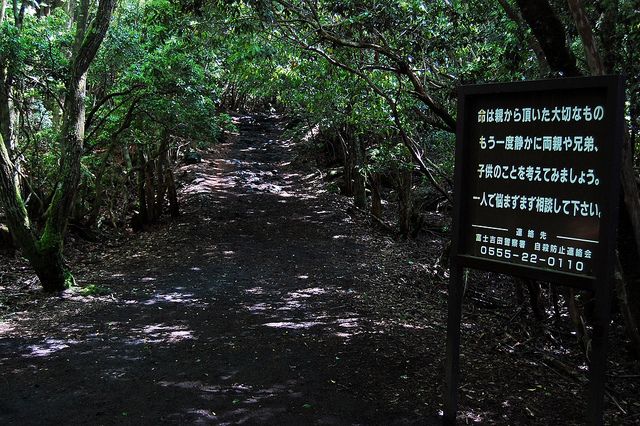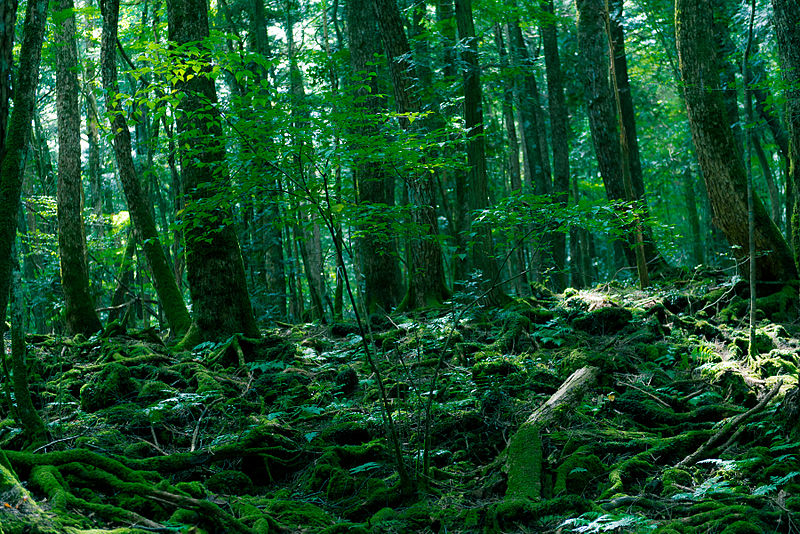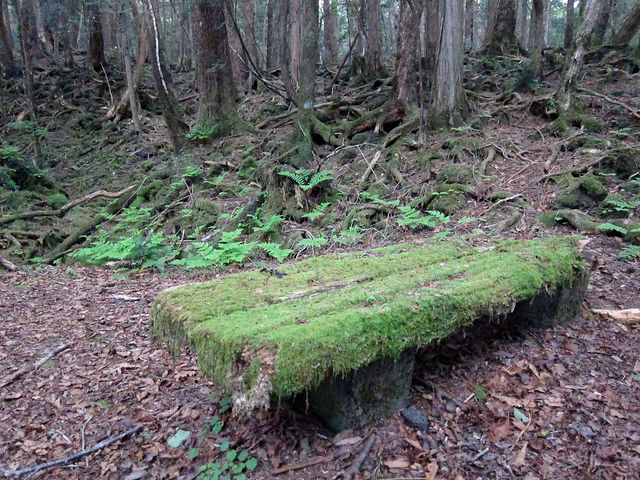With Natalie Dormer chiller The Forest set to hit DVD in June, we take a look at the disturbing real life Suicide Forest in Japan that provided inspiration for the film.

(Image: Keio)
The Legend behind Japan’s Suicide Forest
Every year, assembled groups made up of Japanese police and volunteers comb through the thirty-five kilometer expanse known as the Aokigahara Forest in search of bodies of sad souls who simply could not stand to be among the living any longer. On average, this annual search for the deceased yields between fifty and one-hundred bodies, and while much of the remains are unidentifiable as time had eaten all but the victims’ bones, the bodies stumbled upon which are still identifiable having deceased more recently are placed in a basement-turned-morgue in a nearby forest station. According to employees, in order to keep the spirits of the bodies from running wild and screaming incessantly throughout the night, some unfortunate worker must remain in the room with the fresh corpses, over night. Lucky them. Providentially, the search also bears a few straggling confused folks who were unsuccessful in taking their own life—severe headaches and dehydration due to a few too many sleeping pills, sore necks due to an incorrectly-knotted noose malfunctioning, extreme nausea and dizziness from the inhalation of carbon monoxide. These few are taken for immediate treatment and psychological help.
The Aokigahara Forest—also known as the Sea of Trees, the Demon Forest and most popularly the Suicide Forest—is a 35 kilometer expanse that rests at the foot of the majestic Fuji Mountain. This lush and abundantly green landscape sitting atop of several-hundred year old lava is almost alien, with trees towering toward the sky, swallowing everything below, allowing only fragments of sunlight through to the mossy floor. Certain spots are devoid of any light at all because of the opaque blanket of foliage overhead. From the sky, the treetops are an ocean of green wave, while the jutting rocky moss-covered lava foundation of the forest has proven unstable and dangerous. Many have fallen through fissures in the floor, finding themselves at the bottom of one of hundreds of echoing caves and the new recipients of fractured bones. Due to a profusion of magnetic iron contained in the lava floor, cellular phones as well as compasses and navigation systems seldom work, and the forest is so thick, it’s easy lose track of coming or going—what’s in front of you is identical to what’s behind you. Sound is practically muffled, the density of the verdant woodland absorbing voices and calls for help. This explains the remains of unfortunate seemingly-prepared hikers with their gear, thermoses, Cliff Bars, who became disoriented and lost, eventually starving to death. Some who dare to venture into the forest’s walls string brightly-colored tape around branches and into the dense greenery, using it as a guiding system for finding their way back. That is, if they decide to return. These strings of fluorescent tape sometimes lead to an unhappy ending—a treasure at the end of a rainbow made up of clothed-but-fleshless bones, torn family photos, suicide notes bleeding with sadness, empty abandoned tents that house the final memories of the departed, memories that will never be shared. The tape leading to the graves indicates indecisiveness on the part of the deceased. They wanted to have the option to find their way back, but once inside, something happened. Something materialized between the trees that had convinced them that dying was the best option. They had accepted their fate; there was no going back.

(Image: Jordy Meow)
In Ancient times, Japanese families would bring their elderly and their sick, abandoning them in the unforgiving forest, lost forever, in order to save food during times of famine. The forest already being deemed a place of death was only amplified by a novel written in 1960 that ended with two young lovers committing suicide within the forest’s suffocating walls. The book published and in circulation, the body count began to surge. There was another popular yet very controversial book published in 1993 titled The Complete Suicide Manual. It detailed various ways of executing a successful suicide, literally a step-by-step guide on how to kill yourself. The manual spoke to the Aokigahara Forest being the “perfect place to die.” Since it’s release, the body count within the forest has continued to rise, and this book has accompanied many a lost soul on their journey, left like a tombstone atop of what used to be a living, breathing person, now only deteriorating biological matter and what could’ve been. Visiting the forest, you shouldn’t be surprised to see a lifeless dangling body suspended in air, no longer swinging (there’s almost no breeze that makes it inside the walls). Being that this forest is home to one-to-two deaths every week, chances are that if you look hard enough and venture far enough, you’ll stumble across someone’s grave, and hanging is the most popular method used in the forest. After hanging, it’s the consumption of too many sleeping pills, which is a distant second place, that sometimes leads to delirious, dehydrated people being rescued against their will, given another chance at the life they so hoped to escape.
If you are a spiritual person, you’re probably asking, what happens to all of the spirits of the folks who are successful are successful in taking their lives—all of the tortured souls that die within the Suicide Forest? Some Japanese spiritualists believe the forest consumes the spirits—the reaching trees, climbing vines, blanketing moss permeated by these tormented souls—the spirits of the dead trapped forever inside the forest’s depths. They believe the forest itself is a living specter who will entice those individuals who are curious enough to step foot in, pulling them deeper and deeper into obscurity, to die lost and alone. Others believe that the suicidal become Yurei which is a cross between a ghost, a demonic goblin, and a tarnished soul. They typically appear as a young Japanese girl with pitch black, long, messy hair, wearing white, and floating above the ground with no feet to drag. Legend has it both the trees and the Yurei are evil and manipulative, seeking only one thing: your demise.
Reading through various articles written by folks that had actually gone inside of the Aokigahara Forest, there seems to be a recurring theme. They report a feeling like they were being pulled into the forest by something—something unexplainable—something almost supernatural. There are also consistent reports of hearing faint screams coming from beyond the marked path, the yelps coming from someone in both excruciating pain and fear. Some have disregarded the signs warning to Do Not Enter and hurriedly tried to find and help the distressed causes of the screams but to no avail. Sometimes these screams have led to fresh gravesites, the dead obviously having died long before the scream hit the air. Perhaps the screams are only part of the Yurei’s tricks to get you off the path and beyond the Do Not Enter signs. Some ill-fated, trusting hikers may still be out there, chasing screams, disoriented and running out of food and water, left adrift amidst the Sea of Trees.
Is the Aokigahara Forest truly haunted? There’s got to be a reason upwards of one hundred people venture into this forest on a one-way trip to their death, every year. Are supernatural elements at play? Are there angry spirits or Yurei? Is the forest itself possessed by the same tortured souls it consumed?

(Image: Seb)
Being the skeptic that I am, I’m of the school that thinks you can believe anything under the right conditions. You’re told the forest is haunted, so you see things; you hear things. You’re told that the forest will pull you in, so you feel like you’re being pulled, and perhaps you are, by your own psychological curiosities. I’m not discounting any of the witness’ ghostly accounts of screams or weird feelings or sightings of white apparitions, or people who have simply disappeared inside the dense green landscape, never to be seen or heard from again, their bodies never given a proper burial, their souls trapped forever inside the Suicide Forest. I’m merely offering an alternative, a skeptic’s point of view, a psychological look into why people are drawn to this forest, entering once and never leaving. Because maybe—just maybe—the haunting macabre reality is too frightening to accept.
Although I won’t be traveling to the Aokigahara Forest—at least anytime soon—I know some of you may let curiosity lead you there. Some of you may even feel like you’re being called there, a yearning to experience it, a nervous tick that won’t allow you to rest until you make the trip. Fate. If there’s one piece of advice I can offer, no matter what you think you hear or see, no matter what you feel as you step foot beneath the towering trees as euphoric as it may seem, that pulling feeling, there are signs placed all along the path. These signs are there for a reason. Take heed, my friend. Take heed.
Danger: Do Not Enter.
MATT MICHELI










1 comment
Your warning is well made. Some places in this world are just plain evil, regardless of one’s personal spiritual beliefs. This is definitely one of them. It is significant people were brought there to die in ancient times and abandoned there. Evil begets evil. Perhaps this is what started it, God only knows. But this place is evil. You do a masterful job of describing its atmosphere in both psychological and otherworldly terms, Your choice of pics only makes your case stronger. Stay on the path. Do not enter. I hope people who read this listen.